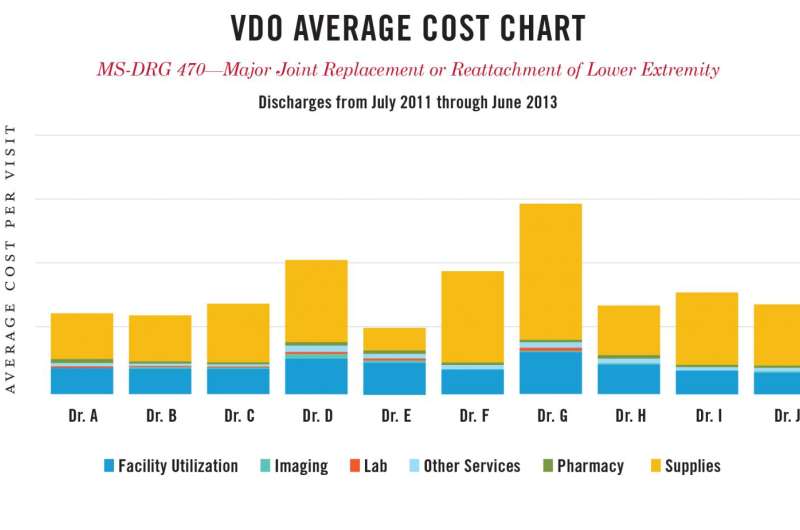Moving the needle on health care quality and costs

Bucking national trends, a new study shows that a program is making a difference in healthcare quality and cost. Developed by University of Utah Health Care (UUHC), the so-called value driven outcomes (VDO) program breaks down health procedure costs to the level of each bandage and minutes of nursing time, revealing variabilities that are otherwise hidden from view. After addressing inefficiencies exposed in three common procedures - joint replacement, in-hospital laboratory testing, and sepsis management - patients fared better and costs fell by up to 11 percent. The results were published online in the Journal of the American Medical Association (JAMA) on Sept. 13.
"The transition of health care from volume to value is no longer theoretical, or wishful thinking," states an accompanying editorial written by health care transformation leaders, Michael E. Porter, Ph.D., a Harvard Business School strategist, and Thomas Lee, M.D., M.Sc., chief medical officer for Press Ganey Associates. "This article shows that achieving better quality and lower costs is possible, and everyone can benefit: patients, hospitals and physicians, and society."
"In order to provide higher value care, we need to better understand our costs," explains lead author Vivian S. Lee, M.D., Ph.D., M.B.A., senior vice president at University of Utah Health Sciences and CEO of UUHC, which has 1.7 million patient visits each year. "We're making the case that an organization can quantify and manage value, and that's going to be a huge part in improving the health care system."
A case in point: knee and hip replacements, which - along with the likes extensive burns, Cesarean deliveries, and drug and alcohol abuse - was placed on a list of 19 procedures with the highest total direct costs. Though plucking out a damaged knee and replacing it with an implant may sound like an assembly-line procedure, analyses with VDO revealed that costs varied considerably between what should have been nearly identical surgeries.
"We were able to get a macro-level view of where the opportunities for improvement were," says senior author Robert Pendleton, M.D., chief medical quality officer at UUHC. "Then, we could drill down even further to see what we needed to change."
Combing through millions of fields of data, VDO analyses determined that a stand-out culprit behind variations in cost for joint replacement surgeries was the length of hospital stays. It took longer for some patients to be discharged than others.
For the multidisciplinary team of doctors, nurses, and operations engineers who were charged with problem solving, the newly exposed issue was a worry for two reasons. It became clear that patients weren't consistently getting out of bed and moving within a day after surgery, a measure that is important for optimal recovery. And when patients stayed in the hospital longer, facility utilization costs creeped upward.
To ensure that every patient had early mobility, the team reconfigured physical therapists' schedules so that one would be available no matter what time of day a patient's surgery took place. Within two years after implementing the changes, the mean length of hospital stays dropped from 3.5 days down to 2.9. During that time, total costs for joint replacements fell by about 10 percent, with 30 percent of that savings coming from shorter times in the hospital.
Another large proportion of the total cost reduction, 40 percent, came from standardizing supplies, an additional major source of variability in the procedure's costs. Administrators renegotiated supply contracts, and made sure that surgeons used implants and other supplies that were under discount.
More important than cost savings, patient outcomes improved. Within one and a half years, a composite score reflecting the quality of care rose from 54 to 80 percent. According to a number of nationally and locally defined quality measures, patients were having fewer complications such as hospital acquired infections, unplanned readmissions, and emergency department visits.
"Many people worry that when you talk about lowering costs, you are talking about inadequate care," says Lee. "Here we see that quality is moving up, and as it moves up, costs go down."
Implementing the VDO program on two additional, common procedures had similar impacts. In the case of in-hospital lab testing for acutely ill patients, the program revealed that some health care providers were ordering unnecessary tests. An education campaign drove down superfluous testing, decreasing mean costs from $138 to $123, or 10 percent, per day. In a pilot project for management of sepsis, one of the top three killers in hospitals, streamlining procedures and raising awareness of warning signs shortened the mean time to administering potentially life-saving antibiotics from 7.8 to 3.6 hours.
"We have great data, but this is just the beginning," says Pendleton. The program is expanding to optimize other procedures, and new versions of VDO are factoring in additional measurements such as patient reported outcomes that take into account the patient's own point of view of how well they think are doing.
"I feel like by the time I retire I'm going to think, 'Oh my gosh, how could we have not even been thinking about value and quality back then? It's hard to imagine,'" says Lee.
More information: JAMA, jama.jamanetwork.com/article.a … 1001/jama.2016.12226
















